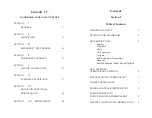
Pilot Operating Handbook
Cavalon
SECTION 10
SAFETY TIPS
AutoGyro_POH_Cavalon 915iS
Revision 1.0 – Issue Date 08.MAY.2019
10-2
Flying Low on Fuel Is Dangerous
Never intentionally allow the fuel level to become critically low. Although a gyroplane leaves
much more options than a fixed wing aircraft and is easier to control during power-off than a
helicopter, a forced landing into unknown terrain always poses unnecessary and
unpredictable risk with danger to material, health, or life.
Do Not Push the Envelope and Remain Easy On the Controls
Avoid abrupt control inputs or accelerated manoeuvres, particularly at high speed. These
produce high fatigue loads in the dynamic components and could cause a premature and
catastrophic failure of a critical component.
Strobe Lights On – For Your Own and Other’s Safety
Turn the strobe lights (if installed) on before starting the engine and leave it on until the rotor
stops turning. The strobe lights are located near the propeller and provide a warning to
ground personnel. Leaving them on in flight is also advisable since the gyroplane may be
difficult for other aircraft to see.
Propellers and Rotors Can Be Extremely Dangerous
Never attempt to start the engine until the area around the propeller is completely clear of
any persons or objects. Do not start the engine while standing beside the aircraft as you will
easily be struck by the propeller in case of a brake failure or an operating error.
Be sure ground personnel or onlookers don't walk into the propeller or main rotor. Mind the
spinning rotor and propeller when taxiing close to obstructions or persons. It is advisable to
maintain at least one rotor diameter distance from obstructions or persons when taxiing with
spinning rotor. A fast turning rotor is almost invisible, but may contain enough energy to
seriously injure a person.
Never let go of the control stick and make sure the rotor blades spin down in level/horizontal
attitude until the rotor is at a complete stop. Wind or negligent behaviour on the control stick
may cause the blades to flap dangerously low and hit control stops, stabilizer, or people.
Power Lines and Cables Are Deadly
Flying into wires, cables, and other objects is by far the number one cause of serious
accidents in rotary wing aircraft. Pilots must constantly be on the alert for this very real
hazard.
Watch for the towers; you will not see the wires in time
Fly directly over the towers when crossing power lines
Allow for the smaller, usually invisible, grounding wire(s) which are well above the
larger more visible wires
Constantly scan the higher terrain on either side of your flight path for towers
Always maintain at least 500 feet AGL except during take-off and landing. By always
flying above 500 feet AGL
Loss of Visibility Can Be Fatal
Flying any aircraft in obscured visibility due to fog, snow, low ceiling, or even a dark night
can cause a very serious accident. Gyroplanes have less inherent stability and faster roll









































